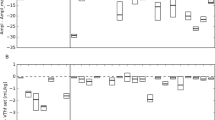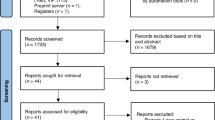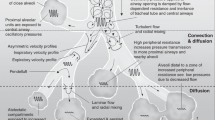Abstract
Abstract: We tested the hypothesis that high frequency oscillatory ventilation (HFOV) would result in decreased pulmonary barotrauma in infants with hyaline membrane disease by comparing HFOV at 10 Hz to conventional positive pressure ventilation with continual distending airway pressure (PPV/PEEP) in premature baboons with hyaline membrane disease. Nineteen baboon fetuses were randomized to one of two treatment groups, delivered at 140 ± 2 days, and, after stabilization and instrumentation of PPV/PEEP, placed in their respective ventilator group. Animals on conventional ventilation were managed by adjustment of tidal volume and frequency (to 1 Hz) to keep PaCO2 below 55 and by adjustment of the mean airway pressure. One of the “HFOV” group died of cardiovascular complications before going on HFOV and was eliminated from data analysis. The remaining HFOV baboons survived the 11-day experimental period without evidence of airleak. Six of the 11 prematures treated with PPV/PEEP developed pulmonary interstitial emphysema and/or pneumothorax and five of the animals died within 48 h. The intergroup differences in airleak were significant (p < 0.05). Mean airway pressure (measured at the proximal airway) was higher initially with HFOV but then was lowered more rapidly than in the PPV/PEEP animals. The arterial to alveolar oxygen ratio rose and the FIO2 could be lowered more rapidly with HFOV than with conventional ventilation. These differences reached significance by 20 h. After 60 h there were no significant differences between HFOV and the PPV/PEEP survivors. HFOV resulted in more uniform saccular expansion, higher arterial to alveolar oxygen ratio, less oxygen exposure, and decreased acute barotrauma when compared to PPV/PEEP. Although initially mean airway pressure was in the HFOV animals this was not associated with measurable baroinjury. These data support the efficacy of HFOV in the treatment of prematures with hyaline membrane disease.
Similar content being viewed by others
Article PDF
Author information
Authors and Affiliations
Rights and permissions
About this article
Cite this article
Delemos, R., Coalson, J., Gerstmann, D. et al. Ventilatory Management of Infant Baboons with Hyaline Membrane Disease: The Use of High Frequency Ventilation1. Pediatr Res 21, 594–602 (1987). https://doi.org/10.1203/00006450-198706000-00018
Received:
Accepted:
Issue Date:
DOI: https://doi.org/10.1203/00006450-198706000-00018
This article is cited by
-
First week of life respiratory management and pulmonary ventilation/perfusion matching in infants with bronchopulmonary dysplasia: a retrospective observational study
Journal of Perinatology (2023)
-
Using very high frequencies with very low lung volumes during high-frequency oscillatory ventilation to protect the immature lung. A pilot study
Journal of Perinatology (2016)
-
High-frequency nasal ventilation for 21 d maintains gas exchange with lower respiratory pressures and promotes alveolarization in preterm lambs
Pediatric Research (2014)
-
Reduction in ventilator-induced lung injury improves outcome in congenital diaphragmatic hernia?
Pediatric Surgery International (2008)
-
Randomized, Multicenter Trial of Conventional Ventilation Versus High-Frequency Oscillatory Ventilation for the Early Management of Respiratory Failure in Term or Near-Term Infants in Colombia
Journal of Perinatology (2005)



